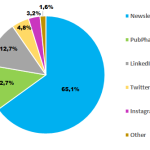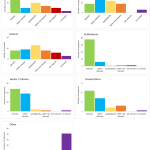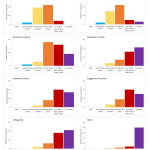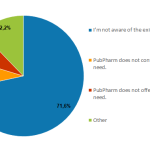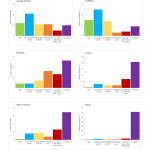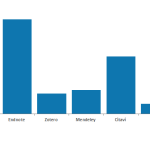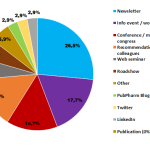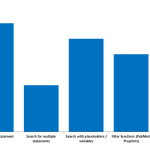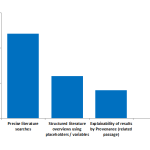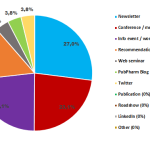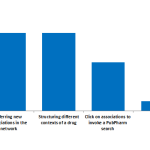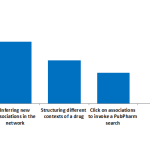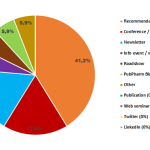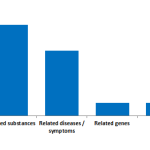Results of the user survey 2022: Part 1
Feedback from the pharmaceutical research community supports the continuous optimisation and development of all services of the FID Pharmazie and the PubPharm research platform. An online survey was conducted from July to September 2022 to specify user needs, identify potential services, and better understand user behaviour. Approximately 2,500 people from the 22 pharmacy universities in Germany were contacted via email and informed about the survey directly on PubPharm. In addition, the survey was advertised on the social media channels of the FID (PubPharm Blog, Twitter, LinkedIn) and events attended during this period (e.g., the Annual Meeting of the Deutsche Pharmazeutische Gesellschaft (DPhG)). Multipliers drew attention to this survey through their channels.
The questionnaire, available in English and German, included three sections: general questions (e.g., about the field of activity), questions about literature/information search (e.g., on the use of search tools and functions) according to the self-assessment of the participants into “PubPharm users” (familiar with PubPham) and “PubPharm non-users”, questions on the innovative search tools developed at the Institute for Information Systems (IfIS) (including the Narrative Service), and finally questions on the topic of research data management.
155 persons participated in the survey, of which 117 (N) fully completed their questionnaire. The results were evaluated primarily based on the fully completed questionnaires. Percentages are rounded.
The results are used for the further development of the FID Pharmazie and optimisation of the services. For this purpose, the comment fields of incomplete questionnaires were also evaluated.
Participants of the survey
68.4% of the participants belong to a university (where you can study pharmacy). The remaining persons are employed at other universities (17.1%), hospitals (5.1%), non-profit research institutions (4.3%), industry (2.6%), governmental/federal labs (<1.0%), pharmacy shops (<1.0%) or other (<1.0%) (e.g., university hospital) (Fig. 1). PhD students form the largest group of participants with 39.3%, followed by research associates and (assistant) professors, who make up about 20.5% and 16.2% of the respondents, respectively (Fig. 2). Other participants include postdocs (9.4%), PhD with habilitation (3.4%), students (<1%) and, under the category of others (10.3%), academic councillors, employed pharmacists and hospital pharmacists.
The fields of activity of the participants in the last five years cover all parts of the interdisciplinary subject of pharmacy. A large proportion of participants are or were active in Pharmaceutical Chemistry (21.4%), Pharmaceutical Technology (19.7%), followed by activities in Pharmaceutical Biology (12.0%), Medicinal Chemistry (12.0%), Clinical Pharmacy (10.3%), as well as Pharmacology and Toxicology (10.3%) and History of Pharmacy (2.6%) (Fig. 3). Other (12.0%) included drug information, pharmaceutical analytics and biotechnology, and publication support/systematic literature review.
- Figure 1 to the question “What kind of institution do you belong to?” (N=117)
- Figure 2 to the question “In which pharmaceutical discipline are you currently active, or have you mainly researched / worked in the past 5 years?” (N=117)
- Figure 3 to the question “I am:” (N=117)
According to the self-classification into “PubPharm users” (47; 40.2%) and “PubPharm non-users” (70; 59.8%), as previously described, participants were asked adapted questions. The survey results were analysed separately for both groups.
Familiar with PubPharm
PubPharm users (n=47) became aware of PubPharm primarily through an email newsletter (36.2%), recommendations from colleagues (23.2%), and activities at conferences, meetings, and congresses (18.8%) (Fig. 4). With 3 to 4% each, the PubPharm blog, road shows, search engines, publications, and flyers were mentioned comparatively rarely as information channels. Direct contact and presentations were also listed under “other”.
In the future, PubPharm users would like to be informed about PubPharm and other services of the FID Pharmazie primarily via newsletter (65.1%) (Fig. 5). Some would also like to exchange information via social media such as LinkedIn (12.7%), Twitter (4.8%), and Instagram (3.2%). 12.7% also indicated they would like to be informed via the PubPharm Blog in the future.
Tutorials were used by 23.3% of the participants as popular information material on PubPharm content and functions (Fig. 6). However, the PubPharm Help Feature (18.3%), commented slide sets (15.0%), and the PubPharm Blog (11.7%) were also frequently used. Furthermore, PubPharm users used handouts (8.3%) and digital flyers (8.3%), as well as the PubPharm Quiz (6.7%). Training courses and direct contact by e-mail were also mentioned under “other”.
- Figure 4 to the question “How did you notice PubPharm?” (x=69 – total number of answers; multiple answers were possible)
- Figure 5 to the question “How would you like to be informed about PubPharm and other FID services in the future?” (x=63 – total number of answers; multiple answers were possible)
- Figure 6 to the question “Which information materials on PubPharm content and functions have you already used?” (x=60 – total number of answers; multiple answers were possible)
The PubPharm users were asked about the relevance of various media types in relation to their own research. They could choose between “not relevant”, “rather not relevant”, “partly/partly”, “rather relevant”, “relevant” and “no answer”. Figure 7 shows that journal publications, dissertations and books, but also clinical studies, preprints and patents are all considered to be particularly relevant. Proceedings, repositories, databases and congress abstracts were also named under “other”.
- Figure 7 to the question “How relevant are the following media types” (e.g., publications, clinical trials, etc.) for your research? (n=47)
The general use and frequency of use of the PubPharm functionalities and components (Fig. 8) could be assessed using the categories “daily”, “several times a week”, “several times a month”, “several times a year”, “less often than several times a year”, or “no response”. The most frequently used functions of PubPharm are the simple literature search via the central search box and the advanced search. Support via email was also mentioned under “other”.
- Figure 8 to the questions “Which of the following PubPharm components and functions do you use? How often do you use them?” (n=47)
Regarding the questions “What can we do to keep you using PubPharm? Which components/functions need to be improved?” and “What do you personally miss? What do you wish for PubPharm?” performance, direct support via email and filter function of the search results were mentioned. The participants would also like to have free electronic access to all issues of the pharmacopoeia and all volumes of the “Pharmazeutische Zeitung” and the “Deutsche Apotheker Zeitung”.
General questions about information search
53 of the PubPharm non-users (n=70) state that they are not familiar with the research platform. Other reasons for not using PubPharm were primarily using other search tools and habits (9; 12.2%). Only rarely was it stated that PubPharm did not have the required content (6; 8.1%) or functions (6; 8.1%) (Fig. 9).
- Figure 9 to the question “What are the reasons not to use PubPharm?” (x=74 – total number of answers; multiple answers were possible)
The search services used by PubPharm non-users are Google Scholar and the PubMed search engine, as well as the licensed databases SciFinder, Scopus and Web of Science. Broader use of PubMed and Google Scholar compared to the licensed services is evident (Fig. 10). Among the other services, Google, Cochrane Library, Embase, Ovid MEDLINE, CINAHL, and PsycInfo were mentioned.
- Figure 10 to the question “Which services (databases, search engines, etc.) do you use?” (n=70)
Analogous to the PubPharm users, the general use, as well as the frequency of use of the functionalities and components (Fig. 11), could be evaluated based on the categories “daily”, “several times a week”, “several times a month”, “several times a year”, “less often than several times a year”, or “no answer”. PubPharm non-users often use simple literature searches, followed by filter functions, advanced search, and structure search. Link lists, blogs, tutorials/webcasts, help functions, favourites lists/export of hit lists and other features (e.g., export of search strategy) are used less frequently.
- Figure 11 to the question “Which components and functions do you use in the databases / search engines mentioned?” (n=70)
On the question “What do you appreciate about the mentioned databases/search engines?”, the participants named speed, ease of use, subject-specific content, and certain functions (e.g., filter functions), among other things. PubPharm non-users were also asked what could be done to make them use PubPharm. One suggestion was to promote awareness so that more people become aware of PubPharm. Additionally, there is a desire to better explain the features available in PubPharm (e.g., via video tutorials) and to make it easier to use, among other things.
Use of literature management programs
Both PubPharm users and PubPharm non-users were asked which literature management program they use in their everyday research. Responses from both groups were compiled in Figure 12. The most commonly used literature management program is Endnote (56 participants). Citavi is also used by 34 respondents in their everyday research. Other programs include Mendeley and Zotero. Among others, JabRef and Reference Manager were named under “other”.
- Figure 12 to the question “Which literature management tool are you using in your daily research activities?” (x=122 – total number of answers; multiple answers were possible)
Innovative tools
In the following part of the survey, participants were asked in detail about the innovative search tools developed at IfIS. The Narrative Service retrieves precise results and generates structured literature overviews. Therefore, users must formulate their information needs by stating the relationships/interactions between pharmaceutical concepts explicitly. The innovative suggestion function in PubPharm generates AI-based lists of context-similar related substances, diseases/symptoms and genes in response to a user’s query for an active substance or a disease/symptom. The relationships between related substances and diseases/symptoms can be visualised in network views (Drug-Target-Disease Networks).
Narrative Service
Of the 117 participants, 89 (76.1%) stated that they did not know the Narrative Service, whereas 22 (18.8%) participants are already familiar with the tool. These participants were asked further questions about the Narrative Service (see Figs. 13-15). Most frequently, these individuals became aware of the service through the email newsletter (26.5%), workshops (17.7%) and conferences (14.7%), and recommendations from colleagues (14.7%) (Fig. 13).
The most frequently used functions in the Narrative Service are the search for a statement and the search with placeholders/variables (Fig. 14). Users of the Narrative Service find the precise literature search particularly relevant (Fig. 17).
- Figure 13 to the question “How did you notice the Narrative Service?” (x=34 – total number of answers; multiple answers were possible)
- Figure 14 to the question “Which function of the Narrative Service are you using?” (x=22 – total number of answers; multiple answers were possible)
- Figure 15 to the question “Which advantages of the Narrative Service are most relevant for you?” (x=22 – total number of answers; multiple answers were possible)
Network views
Of the 117 respondents, 22 were familiar with network views (Fig. 16). These participants were asked further questions about this tool (see Figs. 16-18). They most frequently became aware of this service through the email newsletter (26.9%), conferences, meetings and congresses (23.1%) as well as information events and workshops (23.1%) and also recommendations from colleagues (15.4%) (Fig. 16). Inferring new associations in the network and structuring different contexts of a drug are the most frequently used functions of this service (Fig. 17). Inferring new associations in the network is also considered particularly helpful (Fig. 18).
- Figure 16 to the question “How did you notice the Drug-Target-Disease Networks?” (x=26 – total number of answers; multiple answers were possible)
- Figure 17 to the question “Which functions of the Drug-Target-Disease Networks do you use?” (x=22 – total number of answers; multiple answers were possible)
- Figure 18 to the question “Which advantages of the Drug-Target-Disease Networks are most relevant for you?” (x=22 – total number of answers; multiple answers were possible)
Suggestion function
Of the 117 participants, 16 did know the suggestion function (Fig. 19). These participants were asked further questions about the suggestion function (see Fig. 19-21). They became aware of this service primarily through the recommendation of colleagues (7; 41.2%), as well as through the email newsletter (3; 17.6%) and conferences, meetings and congresses (3; 17.6%) (Fig. 19). Users of the suggestion function indicated in Figure 20 which functions of this tool they use and in Figure 21 which functions they consider to be particularly helpful.
- Figure 19 to the question “How did you notice the innovative suggestion function (related substances, diseases/symptoms and genes)?” (x=17 – total number of answers; multiple answers were possible)
- Figure 20 to the question “Which functions of the innovative suggestion function do you use?” (x=14 – total number of answers; multiple answers were possible)
- Figure 21 to the question “Which advantages of the innovative suggestion function are most relevant for you?” (x=16 – total number of answers; multiple answers were possible)





